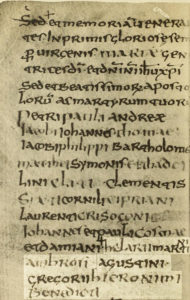Variations in the Saints of the Communicantes

While it is certainly true that the immemorial Roman Canon has remained substantially unchanged for millennia, one small portion of it has been more tolerant of variation than others: the Communicantes.
The Communicantes, as Father Lasance describes it in his Missal,
“…is the beginning of the Action or most solemn part of the Sacrifice. In the following prayer the memory of the Blessed Virgin and the Saints is venerated and their help implored.”
The list of saints in the Communicantes, as we now have it in our modern Roman Missals, proceeds hierarchically through the Apostles and a number of Popes and bishops, finally concluding with martyrs, almost all of whom are Roman and date from the mid-300s or before. The last ones named are Cosmas and Damian.
However, in a number of older rites and liturgical manuscripts, particularly those from France and Milan, additional local and later saints appeared in this list as well.
In the Bobbio Missal, for example, which is thought to represent a Celtic or Gallican Rite of the 600s, we find listed after Cosmas and Damian: Ss. Hilary, Martin, Ambrose, Augustine, Gregory, Jerome, and Benedict.
In the Gelasian Sacramentary of the mid-700s are added Ss. Dionysius, Rusticus, Eleutherius, Hilary, Martin, Augustine, Gregory, Jerome, and Benedict–most of these extra names were partially erased in some manuscripts but remain still visible; other derivative copies have variations of this list.

The Milanese variation of the Roman Canon, seen in the Ambrosian Rite, has its own rather lengthy list of extra saints that formerly also included a number of Milanese confessors. St. Charles Borromeo removed these confessors as part of his reform of the Ambrosian Rite in the late 1500s, but even so that liturgy still retains a unique list, as seen at left.
Other local peculiarities have appeared in the Communicantes over the years, and these continued up to Pius V’s standardization of the Missal in the 16th century; most of them were subsequently discarded. Today, although there are five seasonal variations of the prayer preserved in special Communicantes for the Nativity, Epiphany, Easter, Ascension, and Pentecost, the list of saints has remained fixed across the seasons and generally throughout the Roman rite as well.
However, in his 1889 study of liturgical history before Charlemagne, Louis Duchesne notes that French churches in his day were long accustomed to say the names of St. Hilary and St. Martin at the end of the Communicantes, continuing a long tradition that goes back to the very earliest liturgical sources that have come down to us.
August 31, 2022








